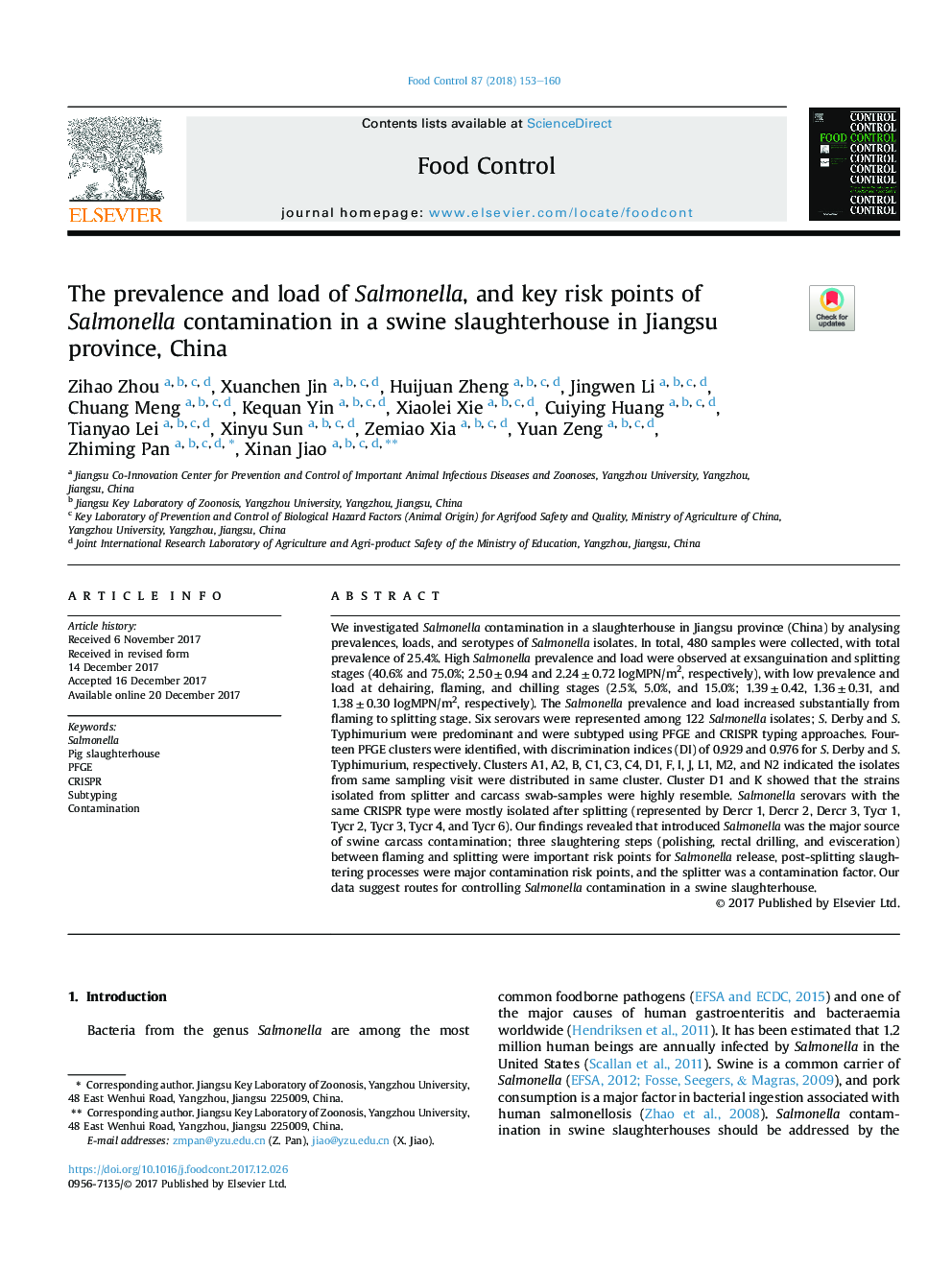| کد مقاله | کد نشریه | سال انتشار | مقاله انگلیسی | نسخه تمام متن |
|---|---|---|---|---|
| 8888081 | 1628377 | 2018 | 8 صفحه PDF | دانلود رایگان |
عنوان انگلیسی مقاله ISI
The prevalence and load of Salmonella, and key risk points of Salmonella contamination in a swine slaughterhouse in Jiangsu province, China
ترجمه فارسی عنوان
شیوع و بار سالمونلا و عوامل خطر اصلی آلودگی سالمونلا در یک کشتارگاه خوک در استان جیانگ سو،
دانلود مقاله + سفارش ترجمه
دانلود مقاله ISI انگلیسی
رایگان برای ایرانیان
کلمات کلیدی
موضوعات مرتبط
علوم زیستی و بیوفناوری
علوم کشاورزی و بیولوژیک
دانش تغذیه
چکیده انگلیسی
We investigated Salmonella contamination in a slaughterhouse in Jiangsu province (China) by analysing prevalences, loads, and serotypes of Salmonella isolates. In total, 480 samples were collected, with total prevalence of 25.4%. High Salmonella prevalence and load were observed at exsanguination and splitting stages (40.6% and 75.0%; 2.50â¯Â±â¯0.94 and 2.24â¯Â±â¯0.72 logMPN/m2, respectively), with low prevalence and load at dehairing, flaming, and chilling stages (2.5%, 5.0%, and 15.0%; 1.39â¯Â±â¯0.42, 1.36â¯Â±â¯0.31, and 1.38â¯Â±â¯0.30 logMPN/m2, respectively). The Salmonella prevalence and load increased substantially from flaming to splitting stage. Six serovars were represented among 122 Salmonella isolates; S. Derby and S. Typhimurium were predominant and were subtyped using PFGE and CRISPR typing approaches. Fourteen PFGE clusters were identified, with discrimination indices (DI) of 0.929 and 0.976 for S. Derby and S. Typhimurium, respectively. Clusters A1, A2, B, C1, C3, C4, D1, F, I, J, L1, M2, and N2 indicated the isolates from same sampling visit were distributed in same cluster. Cluster D1 and K showed that the strains isolated from splitter and carcass swab-samples were highly resemble. Salmonella serovars with the same CRISPR type were mostly isolated after splitting (represented by Dercr 1, Dercr 2, Dercr 3, Tycr 1, Tycr 2, Tycr 3, Tycr 4, and Tycr 6). Our findings revealed that introduced Salmonella was the major source of swine carcass contamination; three slaughtering steps (polishing, rectal drilling, and evisceration) between flaming and splitting were important risk points for Salmonella release, post-splitting slaughtering processes were major contamination risk points, and the splitter was a contamination factor. Our data suggest routes for controlling Salmonella contamination in a swine slaughterhouse.
ناشر
Database: Elsevier - ScienceDirect (ساینس دایرکت)
Journal: Food Control - Volume 87, May 2018, Pages 153-160
Journal: Food Control - Volume 87, May 2018, Pages 153-160
نویسندگان
Zihao Zhou, Xuanchen Jin, Huijuan Zheng, Jingwen Li, Chuang Meng, Kequan Yin, Xiaolei Xie, Cuiying Huang, Tianyao Lei, Xinyu Sun, Zemiao Xia, Yuan Zeng, Zhiming Pan, Xinan Jiao,
